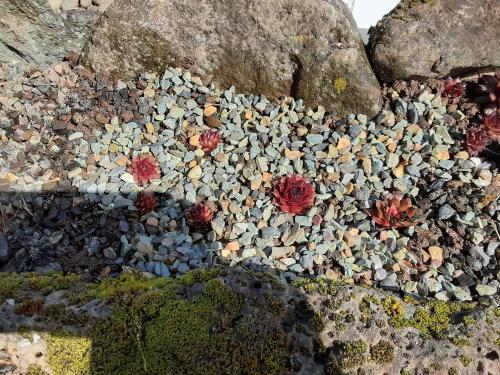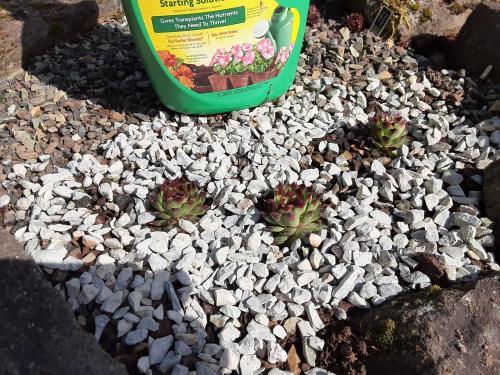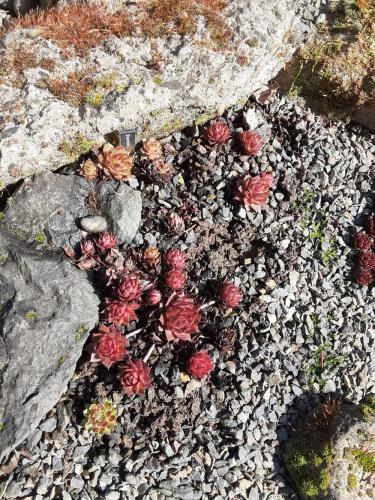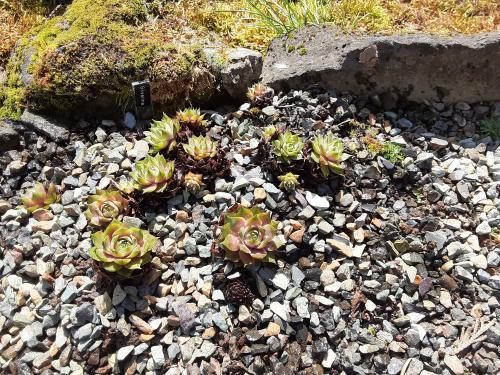Once upon a time I started a semp garden. I constructed rock-lined, raised beds filled with the local native Canby soil excavated from a corner of my yard. I acquired every semp I could get my hands on and planted them throughout my rockery expecting them to take hold and grow and look beautiful.
The results? Spectacular beyond my expectations. Every last one of them was the picture of health and could grace the pages of a Sempervivum journal. In fact a couple did end up in Kevin's recent semp book. (pages 15, 28, 69, 171 thanx Kevin!) As my semps prospered I believed that either I had the midas touch or that semps were totally trivial to grow. Here's a reasonably typical example:
This continued for a few years but eventually my semps fell upon hard times. Here is 'Pepito' today. (the center portion of the pic)

This is below the average but at least it's still alive. I have a handful of name tags of cultivars that either bit the dust or I gave up on. I didn't give up on 'Pepito' because it is such a rare beauty.
So the question is... what the heck is going on?
Instead of blaming myself I used the weather as an excuse. The cold, wet winters do not make semps happy I was told and I do suppose that is true. So I blamed that. But that doesn't hold water cuz the first three years everything increased and prospered. And then there was the 'Purple Dazzler' affair. This semp started out awesome and slowly degraded like so many others. Many attempts were made to help this guy along in situ but its vigor continued downward. In desperation to save its life I moved it into a pot that I could move around and protect it from the nasty, wet winters. It immediately took off with furious growth. But far from protecting it, I neglected it and left it out for two straight winters. Did those nasty winters damage it? Not one little bit. So I have stopped blaming the weather.
'Purple Dazzler' did however offer a strong suggestion that soil was the real issue. The pot I had put it in was filled with a mixture of local soil, peat moss and compost. But then why had I had several years of great success in my semp garden with my local silty loam?
I think the common factor is
air availability to the roots. The pot blend I used is light and fluffy and offers air penetration. And my semp garden soil was excavated and broken up, and so contained an abundance of air pockets of all sizes. But as time goes by this silty loam settles down and is very dense. The local vegetable farmers love it but they also do cover crops and regular discing, and they also use raised rows. I guess I could learn a thing or two from them.
Looking back at many new semp introductions into my declining semp garden, I have to confess to a cardinal sin. When planting offsets I would only open the soil just enough to insert the roots and expected that to work fine. And it sorta did and sorta didn't. I should have taken the opportunity to dig up as much soil as possible to make it easier for root expansion.
So... it is time for atonement. The root zone must be improved. Here is 'Pepito's new situation.

I cleared the gravel away and dug down 8 inches and worked the soil before replanting. Only time will tell if 'Pepito' will return to glory. A dose of QuickStart couldn't hurt.
Another problem area was a NOID calcareum which I dearly loved. It prospered well and then declined like so many others. I tried several times to rejuvenate it with offsets taken from a separate planting and those all failed. I was again being lazy and not working the soil. So here again I've finally made the effort to work the soil down 8 inches to lighten it up. Here's the new planting and we'll see if this one takes off.

The real solution it seems would be to re-dig the entire semp garden. I really, really don't want to do that. I'm wondering if there's an easier way. I picked out a few cultivars that were looking a bit weak and tried an experiment on them. I took a small trowel and drove it into the soil all around each semp and "popped" the soil up. Kind of like using a broadfork but on a much smaller scale. It will likely do some root damage but will also introduce some air into the soil. I'm trying this on 'Starshine', 'Silverine' and 'Purple Dazzler'. I have pictures of the first two so I can compare later.


I'm thinking if this works I can make it a yearly task to 'pop' the soil on the same day that I apply Quickstart in Spring. My guess is that it will improve the situation but never back to the glory days. I can live with that.
I'll try to remember to post updates here as I get results. It shouldn't be too long as I did all this at least two weeks ago.





